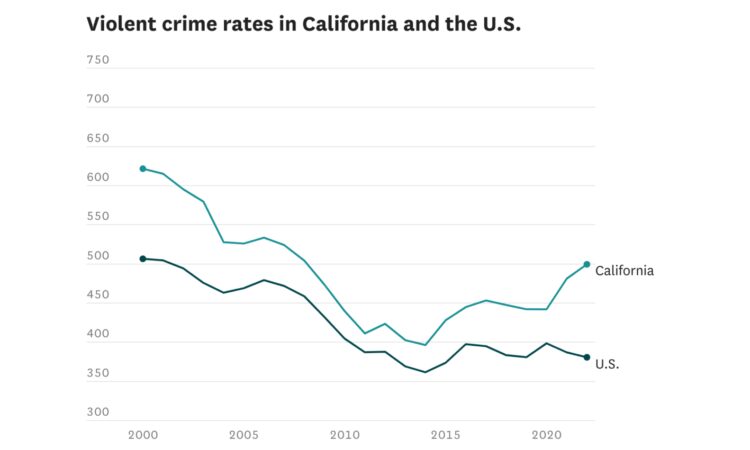
FBI data revealed violent crime increased for the second year in a row in California, while it declined nationwide.
Yalonda M. James/The ChronicleCalifornia’s violent crime rate increased for the second year in a row in 2022, while violence in the United States overall declined. But the state’s property crime increased only modestly and in line with the rest of the country.
These findings come from the FBI’s latest annual release of crime data collected via its Uniform Crime Reporting Program, which collects data from law enforcement agencies across the country.
The most important trend shown by the data is a drop in homicides nationwide. After homicides jumped by nearly a third in 2020 — the single biggest year-over-year increase in more than a century — and rose slightly again in 2021, they dropped in 2022 by just over 6%, an even faster decline than the overall violent crime rate drop of about 1.6%.
Advertisement
Article continues below this ad
California followed the national trends; its homicide rates, which are lower than the broader U.S. rate, went up by 39% from 2019 to 2021, then back down again by 5% in 2022.
While the U.S. saw its overall violent crime rate decline in 2022 alongside the homicide rate, California’s reported violent crime rate has increased over the past two years. That jump stems from a significant spike in aggravated assault, which has risen by 24% since 2019. Robberies too rose slightly in 2022, though they remain lower than any year in the last two decades aside from 2020-21.
California’s overall violent crime rate in 2022 stood at 500 reported crimes per 100,000 people, the highest it’s been since 2008 but still low relative to the highs of the 1980s and 90s.
But — perhaps surprisingly given the nationwide attention given to California’s struggles with theft — the state’s reported property crime rates in 2022 remained lower than at almost any point in the last four decades. Property crime rose slightly last year, but that rise coincided with a similar increase in the U.S. overall. This mostly indicates the return to pre-pandemic life that took place in 2022, Jeff Asher, crime analyst and co-founder of AH Datalytics, told the Chronicle.
Advertisement
Article continues below this ad
Anyone reading FBI crime data should take it with a grain of salt, especially when zooming in to a specific crime type or agency, Asher said. Until recently, the agency’s data was based on a “hierarchy” model, where if multiple crimes occur in a single incident, only the most serious was counted. This system leads certain crime types — especially petty offenses like theft — to be underreported. Surveys of victims also show that many other crime types are also severely undercounted.
Asher said there’s been no evidence or “hard data” to show that property crimes are more underreported than they once were. Thus, he and other criminologists believe that the FBI data is better at showing trends over time than capturing raw rates of crime (except for certain serious crimes, like homicide, which the FBI captures pretty accurately). Homicides are considered the most reliable data collected by the FBI, because such crimes rarely go unnoticed by police.
The FBI made all agencies report their data via a new system in 2021, but most California agencies didn’t participate, making the state’s 2021 figures far less reliable than prior years. While all years of FBI data are estimates, not accurate counts, the agency based its 2021 estimates on just 348 out of 832 UCR-participating agencies; in contrast, it based its 2022 and 2020 estimates off 732 and 817 agencies, respectively.
In 2022, the FBI let agencies choose which reporting system to use, leading to far more comprehensive statistics at the state and local level.
Advertisement
Article continues below this ad
Reach Susie Neilson: susan.neilson@sfchronicle.com

